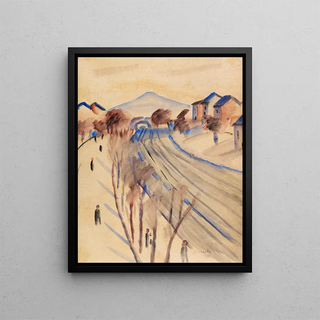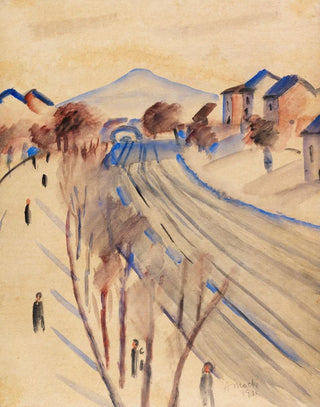Art print | Berg with railway tracks II - August Macke


View from behind

Frame (optional)
Art print Berg with railways II - August Macke – Captivating introduction
In the vibrant universe of modern art, the work "Berg with railways II" by August Macke stands out for its boldness and its ability to evoke deep emotions. This painting, which belongs to the expressionist movement, transports the viewer to a landscape where nature and industrialization coexist harmoniously. Macke, with his vivid palette and keen sense of composition, manages to capture the essence of a fleeting moment while inviting reflection on the relationship between man and his environment. The art print of this piece is much more than a simple image; it is an invitation to explore a world where beauty and modernity meet.
Style and uniqueness of the work
"Berg with railways II" is characterized by its daring use of colors and shapes. Macke, a true master of color, plays with bright hues that seem to dance across the canvas, creating a striking contrast between the lush green hills and the geometric lines of the railways. This painting perfectly illustrates an artist's vision that seeks to express not only the beauty of the landscape but also the impact of modernity on it. The stylized forms and dynamic perspectives give an impression of movement, almost of life, to the work. Every element, whether the undulating hills or the winding rails, contributes to a harmonious composition that invites the viewer to explore every corner of the canvas.
The artist and his influence
August Macke, an emblematic figure of German expressionism, knew how to leave his mark on his era through an innovative approach to painting. Born in 1887, he quickly developed a style that combines poetic sensitivity with a critical analysis of his time. Influenced by artists such as Henri Matisse and Paul Gauguin, Macke experimented with color and form, seeking to transcend reality to touch the very essence of human emotions. His work, although sometimes tinged with melancholy, is also a celebration of life and nature. By incorporating everyday elements into his compositions, he paved the way for a new way of perceiving the world, making him a

Matte finish

View from behind

Frame (optional)
Art print Berg with railways II - August Macke – Captivating introduction
In the vibrant universe of modern art, the work "Berg with railways II" by August Macke stands out for its boldness and its ability to evoke deep emotions. This painting, which belongs to the expressionist movement, transports the viewer to a landscape where nature and industrialization coexist harmoniously. Macke, with his vivid palette and keen sense of composition, manages to capture the essence of a fleeting moment while inviting reflection on the relationship between man and his environment. The art print of this piece is much more than a simple image; it is an invitation to explore a world where beauty and modernity meet.
Style and uniqueness of the work
"Berg with railways II" is characterized by its daring use of colors and shapes. Macke, a true master of color, plays with bright hues that seem to dance across the canvas, creating a striking contrast between the lush green hills and the geometric lines of the railways. This painting perfectly illustrates an artist's vision that seeks to express not only the beauty of the landscape but also the impact of modernity on it. The stylized forms and dynamic perspectives give an impression of movement, almost of life, to the work. Every element, whether the undulating hills or the winding rails, contributes to a harmonious composition that invites the viewer to explore every corner of the canvas.
The artist and his influence
August Macke, an emblematic figure of German expressionism, knew how to leave his mark on his era through an innovative approach to painting. Born in 1887, he quickly developed a style that combines poetic sensitivity with a critical analysis of his time. Influenced by artists such as Henri Matisse and Paul Gauguin, Macke experimented with color and form, seeking to transcend reality to touch the very essence of human emotions. His work, although sometimes tinged with melancholy, is also a celebration of life and nature. By incorporating everyday elements into his compositions, he paved the way for a new way of perceiving the world, making him a






